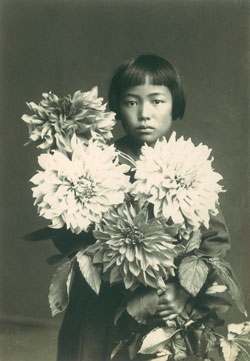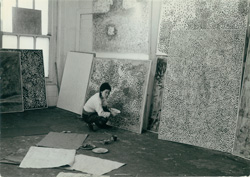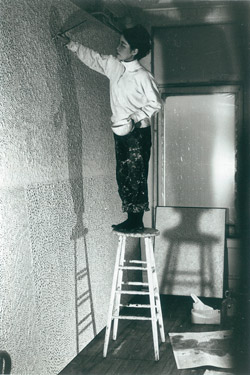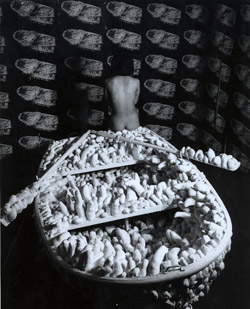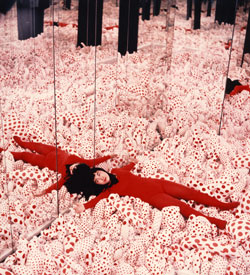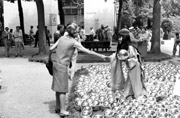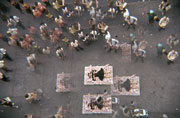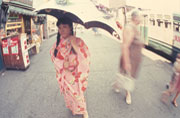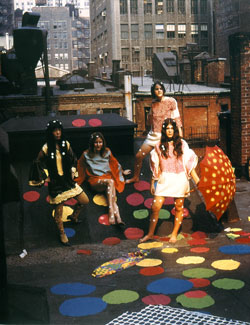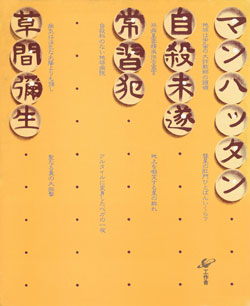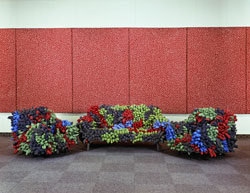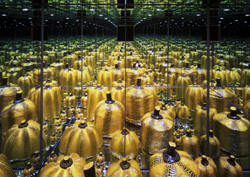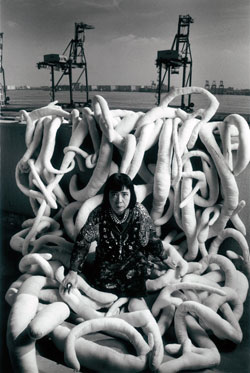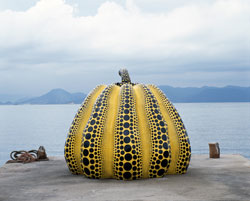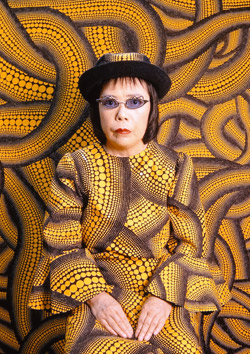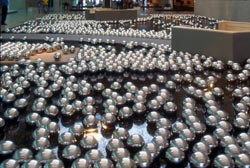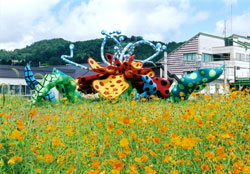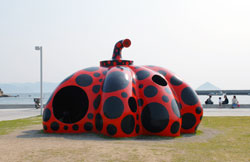EARLY LIFE: JAPAN
Yayoi Kusama is born on 22 March, in Matsumoto City, Nagano prefecture, Japan; she is the fourth child in a prosperous and conservative family.
Around the age of ten, Kusama begins using polka dots and net motifs in her drawings, watercolours, pastels and oils. She later attributes this to a series of hallucinations, the result of a volatile family environment.
Yayoi Kusama, 1939 / Image courtesy: Ota Fine Arts, Tokyo / © Yayoi Kusama, Yayoi Kusama Studio Inc.
At around 20, she leaves home to enter senior class at Kyoto Municipal School of Arts and Crafts, where she studies nihonga (Japanese-style painting); she graduates the following year.
A nihonga painting entitled Cat 1947 is selected for the First Nagano Prefecture Exhibition.
Working in watercolour, gouache and oils, Kusama produces work at an astonishing rate. Her first solo exhibition, held in March at the First Community Centre, features 250 works, while a second exhibition at the same venue in September includes a further 280. Her work comes to the attention of psychiatrists Dr Shiho Nishimaru and Dr Ryuzaburo Shikiba. Plans by Shikiba to exhibit her work in the United States are not realised.
Kusama turns down a place at the Académie de la Grande Chaumière in Paris in order to devote time to a solo exhibition in Tokyo.
In February, Kusama holds her first Tokyo solo exhibition at Shirokiya Department Store. Her work is featured on the cover of the journal Mizue. A second exhibition in Tokyo takes place at Mimatsu Shobo Gallery in August.
After three solo shows in the first three months of the year in Tokyo, Kusama’s work is included in the ‘International Watercolor Exhibition: 18th Biennial’ at the Brooklyn Museum in New York. In November, she begins corresponding with American artist Georgia O’Keeffe, sending her 14 watercolours. She also sends work to Kenneth Callahan, a Seattle-based painter.
Through Callahan, she secures a solo exhibition at Seattle’s Dusanne Gallery. Against her family’s wishes, Dr Shiho Nishimaru assists Kusama in obtaining a visa to allow her to travel to the United States.
With news of her American exhibition, Kusama becomes a minor celebrity and the Matsumoto mayor organises a farewell for the artist. Before leaving for the United States, she destroys several thousand of her own works.
UNITED STATES
In December, Kusama holds her first solo exhibition in the United States at Dusanne Gallery, Seattle.
Kusama moves to New York in June, enrolling in the Art Students League of New York in order to obtain a student visa. She begins working on her ‘Infinity Net’ paintings. At this time, her group exhibitions include ‘Modern Japanese Paintings’ at the important artist-run Brata Gallery.
Kusama in her New York studio, c.1958–59 / Image courtesy: Ota Fine Arts, Tokyo / © Yayoi Kusama, Yayoi Kusama Studio Inc.
Kusama debuts her net paintings, including Large White Net 1958, in a group show at Boston's Nova Gallery in June. Her solo exhibition at Brata Gallery in October, featuring five large monochrome canvases, garners glowing reviews from artists and critics, including Sidney Tillim, Dore Ashton and Donald Judd, among others. Judd purchases a painting for $200, paid in four instalments, and the two artists grow close. Kusama holds another two solo exhibitions at Nova Gallery in November and December.
In March, Kusama begins her association with the European Avant-garde when she and Mark Rothko are the only artists from New York to be represented in ‘Monochrome Malerei’, an international survey of contemporary abstraction organised by Udo Kultermann at the Städtisches Museum in Leverkusen, Germany. Her work appears alongside artists of the Zero, Azimuth and Nouveau Réaliste groups (collectively known as New Tendencies); included among them are Lucio Fontana, Yves Klein, Piero Manzoni and Günther Uecker. More exhibitions follow on the United States east coast, and Kusama agrees to be represented by Stephen Radich in New York.
Frank Stella purchases a ‘Yellow Net’ painting from a solo exhibition at Stephen Radich Gallery, where Kusama also meets New Tendency artist Henk Peeters of the Dutch Nul group. She moves her studio into the same building as Donald Judd and sculptor Eva Hesse; Hesse becomes a close friend. Further exhibitions follow in Europe — where she continues to be associated with New Tendencies — and in the United States, including the ‘1961 Whitney Annual’ at the Whitney Museum of American Art, New York. From this time, Kusama is hospitalised regularly from overwork, and a concerned Georgia O’Keeffe convinces her own dealer Edith Herbert to purchase several works in order to help Kusama stave off financial hardship.
Kusama in her New York studio, c.1961 / Image courtesy: Ota Fine Arts, Tokyo / © Yayoi Kusama, Yayoi Kusama Studio Inc.
Kusama participates in more New Tendencies exhibitions in Europe, in which she tends to be the only artist invited who is US-based. Kusama experiments with soft sculpture, often with Judd as an assistant; she produces a series called ‘Accumulations’ at this time. The first two works are exhibited at Green Gallery, New York, alongside future pop and minimal artists, such as Robert Morris, Claes Oldenburg and Andy Warhol. She meets sculptor Joseph Cornell, and the two begin a long-term relationship.
Kusama is granted permanent residency in the United States. Her exhibitions include ‘Aggregation: One Thousand Boats Show’ at Gertrude Stein Gallery in New York; this is the artist’s first installation to exploit the entire gallery space. Those impressed include Andy Warhol and critic Brian O’Doherty, who enthusiastically describes Kusama’s production of a work as both an object and an environment. Other shows see her exhibiting alongside Judd, Morris, Dan Flavin and Larry Poons in the United States; and Fontana, Klein, Manzoni, Peeters, Uecker and Dieter Roth in Europe.
Yayoi Kusama with 'Aggregation: One Thousand Boats Show', Gertrude Stein Gallery, New York, 1963 / Image courtesy: Ota Fine Arts, Tokyo / © Yayoi Kusama, Yayoi Kusama Studio inc.
Kusama starts to include electric lights and mirrors in her installations. For the ‘Driving Image Show’, she fills New York’s Castellane Gallery with ‘Infinity Net’ paintings, objects from her ‘Accumulations’ series, most works from the ‘Aggregation: One Thousand Boats Show’, as well as macaroni-encrusted dresses and mannequins; even live dogs are included. Elsewhere, she shows alongside Arman, Allan Kaprow and Marcel Duchamp, as well as pop artists Warhol, Oldenburg, Jim Dine, Robert Indiana, Roy Lichtenstein and Tom Wesselmann. She garners the critical support of Herbert Read and the New York Times; commercial attention, however, is limited, and her illness returns.
Kusama’s financial circumstances are improved by a Rockefeller Foundation grant and her health improves in the company of artist On Kawara, with whom she shares a studio. Among numerous well-received exhibitions is November’s ‘Floor Show’ at Castellane Gallery, which features her first Infinity Mirror Room 1965, as well as stuffed shoes and a phallus-covered pram. At this time, Kusama also begins to stage her first happenings.
Yayoi Kusama with Infinity Mirror Room — Phalli's Field, Castellane Gallery, New York, 1965 / Image courtesy: Ota Fine Arts, Tokyo / © Yayoi Kusama, Yayoi Kusama Studio inc.
‘Driving Image Show’ is exhibited at the Galleria d’Arte del Naviglio 2 in Milan, where she spends two months working in Lucio Fontana’s studio. Back in New York in March, ‘Kusama’s Peep Show: Endless Love Show’ at Castellane Gallery is the first solo multimedia installation for the artist; hexagonal mirrors, flashing coloured lights, rock music and ‘Love Forever’ badges make up the installation. Fontana funds the production of Narcissus Garden 1966 — 1500 silver balls gathered on a lawn at the Venice Biennale in June. In an attempt to both engage viewers and critique the commercialism of the art world, Kusama sells the balls for 1200 lira ($2) each; she is stopped by Biennale authorities who object to the artist selling her work ‘like hot dogs or ice cream cones’. Other works are exhibited at New York’s Museum of Modern Art in ‘The Object Transformed’ and the Moderna Museet in Stockholm. Critic Lucy Lippard proclaims Kusama a precursor to ‘eccentric abstraction’.
From left to right:
Yayoi Kusama with Narcissus Garden, Venice Biennale, 1966 / Image courtesy: Ota Fine Arts, Tokyo / © Yayoi Yayoi Kusama, Yayoi Kusama Studio inc.
14th Street Happening, 1966 / Image courtesy: Ota Fine Arts, Tokyo / © Yayoi Kusama, Yayoi Kusama Studio inc.
Walking Piece, 1966 / Image courtesy: Ota Fine Arts, Tokyo / © Yayoi Kusama, Yayoi Kusama Studio inc.
Kusama stages a happening at Black Gate Theatre in New York. Entitled Self-obliteration, it features an environment of mannequins and walls covered in polka dots, all under black light — participants are encouraged to draw dots on each other in fluorescent paint. Similar events, which she describes as ‘body festivals’ are staged in parks in New York and at the Chrysler Art Museum in Provincetown and the New Tendencies-allied Galerie Orez in The Hague. Polka-dotted naked men at a happening at a Dutch student jazz club lead to police closure of the venue, as well as tabloid delight. Kusama declares that ‘the body is art’ in a flyer for the Provincetown event.
The film Kusama’s Self-obliteration 1968, documenting the happenings of the previous year, is screened in New York and telecast in Europe. The newly formed Kusama International Film Production Company is set up to assist distribution, but the company faces censorship laws in the promotion of Kusama’s films. Kusama’s happenings grow arguably more radical, as the artist’s ‘The Anatomic Explosion’ demonstrates; featuring public nudity, they are staged throughout New York together with protests against the war in Vietnam, the Soviet invasion of Czechoslovakia, and capitalism generally. Lippard includes the artist in ‘Soft and Apparently Soft Sculpture’, an exhibition also featuring the work of Hesse, Louise Bourgeois, Bruce Nauman, Richard Serra and others. Kusama presides over the happening Homosexual Wedding at the Church of Self-obliteration in Walker Street in New York, and performs alongside Fleetwood Mac and Country Joe and the Fish at the Fillmore East, New York City. Sensational reportage of these events reaches Japan and causes further friction within Kusama’s family.
Fashion shoot on a New York rooftop, 1968 / Image courtesy: Ota Fine Arts, Tokyo / © Yayoi Kusama, Yayoi Kusama Studio inc.
The happening Grand Orgy to Awaken the Dead takes place in the sculpture garden of New York's Museum of Modern Art and receives widespread press coverage; additional happenings and performances take place throughout the year. Other activities include publicly supporting hippy provocateur Louis Abolifia's mayoral campaign by staging a happening in Central Park, and establishing a fashion label selling dresses and textiles out of a boutique on Sixth Avenue.
She returns to Japan for a three-month visit, during which time she is a frequent guest on Japanese television. She is also arrested during a happening in Tsukuji.
Kusama stages a series of street happenings and fashion shows throughout Europe.
Back in New York, Kusama begins to write about her experiences; this material will form the basis of her later literary production.
Following the death of her partner Joseph Cornell, Kusama returns to Japan in declining health. She intends to stay in Japan only a short time, but is living there permanently by 1975.
Kusama turns her attention to ceramics, watercolours, pastels and collage and begins to write poetry. She participates in ‘Woman’s Work: American Art 1974’ at the Museum of Philadelphia Civic Centre in April. Kusama’s father, Kamon, dies in June.
Kusama is hospitalised at Seiwa Hospital in Tokyo’s Shinjuku district. She attempts to settle scandalous accounts of her work in an essay entitled ‘The struggle and wanderings of my soul’ published in Geijutsu Seikatsu (Art Life). In December, Tokyo’s Nishimura Gallery hosts ‘Message of Death from Hades’, an exhibition of new collages and Kusama’s first since returning to Japan. The exhibition attracts the attention of young poet and curator Akira Tatehata.
New two- and three-dimensional works are profiled in ‘Obsessional Art, A Requiem for Death and Life’ at Osaka Formes Gallery in August, while in December Kusama participates in exhibitions at several New York galleries and, as a former Brata Gallery artist, in ‘Tenth Street Days: The Co-ops of the 50s’.
From March, Kusama becomes a permanent resident at Seiwa Hospital, and she opens a studio nearby. In June, she publishes a book of poems and paintings entitled 7.
Kusama’s first novel Manhattan Suicide Addict is published by Kousakusha in March. For the next few years, her only exhibitions of new work are modest showings in Japan; her presence in the United States is limited to collection-based shows.
First edition of Manhattan Suicide Addict, 1978 / Image courtesy: Ota Fine Arts, Tokyo / © Yayoi Kusama, Yayoi Kusama Studio inc.
Kusama is one of 30 artists included in the major survey ‘The 1960s: A Decade of Change in Contemporary Japanese Art’ at the National Museum of Modern Art, in both Tokyo and Kyoto.
A solo exhibition at Fuji Television Gallery in Tokyo, comprising some 30 works, is the first in Japan to show Kusama’s paintings and sculptures from the 1950s and 1960s. A solo exhibition is also held at Milan’s Naviglio Gallery, which features a photograph of Narcissus Garden at the 1966 Venice Biennale.
Galerie Ornis, The Hague, includes 42 works in ‘Yayoi Kusama: 1950–1970’. Kusama’s work is also included in the Los Angeles Museum of Contemporary Art’s inaugural collection exhibition. Published in January, Kusama’s second novel The Hustler’s Grotto of Christopher Street wins Yasei Jidai magazine’s Tenth Literary Award for New Writers.
Kusama devotes the year to writing, and her work is included in ‘Blam! The Explosion of Pop, Minimalism and Performance 1958–1964’ at the Whitney Museum of American Art, New York. Her mother Shigeru dies.
In April, the artist conducts a performance at Tokyo’s Joshinji Temple, while her third novel, The Burning of St Mark’s Church appears in May. Chair 1962 appears in the important ‘Reconstructions: Avant-Garde Art in Japan 1945–1965’ at the Museum of Modern Art, Oxford.
A showing at the Musée Municipal, in Dole, France, is the first international exhibition to concentrate on Kusama’s output from the 1980s, while Chair 1962 is included in the Pompidou’s extensive survey ‘Japon des Avant Gardes 1910–70’. Her book Yayoi Kusama: Driving Image is published in June.
Kitakyushu Municipal Museum of Art in Fukuoka launches Kusama’s first major retrospective, comprising 79 works from the 1940s to the 1980s.
The novel Between Heaven and Earth is quickly followed by Woodstock Phallus Cutter, while new three-dimensional works appear in ‘Yayoi Kusama: Soul Burning Flashes’ at Fuji Television Gallery in Tokyo.
REAPPRAISAL
The Queensland Art Gallery includes Kusama’s 1981 installation Spring Festival in ‘Japanese Ways Western Means’, organised in collaboration with the Museum of Modern Art, Saitama. Kusama’s literary output continues with Aching Chandelier and Double Suicide at Sakuragazuka, appearing in the first half of the year, alongside several issues of the magazine S&M Sniper in collaboration with photographer Nobuyoshi Araki. A major revival of Euro–American interest in the artist’s work is marked by ‘Yayoi Kusama: A Retrospective’ at the Center for International Contemporary Arts, New York, and ‘In Context: Yayoi Kusama, Soul Burning Flashes’ at the Museum of Modern Art, Oxford. She becomes the first Japanese artist to grace the cover of the major art journal Art in America.
Spring Festival 1981, as part of 'Japanese Ways, Western Means: Art of the 1980s in Japan', Queensland Art Gallery, 1989
The novel Angels in Cape Cod is published in February. The artist also designs a hot-air balloon for an exhibition in Paris.
Kusama conducts a Self-Obliteration event in front of the Sony Building in Ginza, in Tokyo, covering the entire space, including spectators and journalists, with polka dots. She shows 23 new paintings and sculptures at the Fuji Television Gallery, while her ninth novel, The Foxgloves of Central Park, is published in April. She finishes the year by starring in the film Tokyo Decadence, written and directed by Ryu Murakami.
Mirror Room (Pumpkin), inside view, Hara Museum of Contemporary Art, Japan, 1991 / Image courtesy: Ota Fine Arts, Tokyo / © Yayoi Kusama, Yayoi Kusama Studio inc.
Kusama’s tenth novel, Lost in Swampland, appears in January, while a book of print works is published in May. Sogetsu Art Museum, in Tokyo, hosts the retrospective ‘Yayoi Kusama: Bursting Galaxies’.
At the invitation of Akira Tatehata, Kusama becomes the first artist to show solo at the Japanese Pavilion at the 45th Venice Biennale. The exhibition brings together important early works from the 1950s, large-scale sculptures and paintings from the 1980s, as well as more recent works. The artist conducts a performance alongside Mirror Room (Pumpkin) during the vernissage in June. The novel New York Story also appears in June. In July, Kusama collaborates with British musician Peter Gabriel on an installation in Yokohama.
Portrait of Yayoi Kusama at Tokyo Bay, 1993 / Photograph: Yuichi Hiruta / Image courtesy: Ota Fine Arts, Tokyo / © Yayoi Kusama, Yayoi Kusama Studio inc.
Several 1960s works by Kusama are included alongside those by Japanese peers Minoru Kawabata, Tetsumi Kudo, Kenzo Okada and Jiro Yoshihara in ‘Japanese Art after 1945: Scream Against the Sky’; the exhibition is shown at the Yokohama Museum of Art, New York’s Solomon R Guggenheim Museum and the Museum of Modern Art, San Francisco. In her Fuji Television Gallery solo exhibition ‘Yayoi Kusama: My Solitary Way to Death’, Kusama presents a hexagonal mirror installation and a never-ending ladder, among other new works. She also produces a music video for Peter Gabriel, and publishes another novel called The Madhouse of Ants. Pumpkin 1994 becomes the first outdoor sculpture to be installed on Naoshima Island in Japan’s inland sea.
Pumpkin, Benesse Art Site, Naoshima, 1994 / Image courtesy: Ota Fine Arts, Tokyo / © Yayoi Kusama, Yayoi Kusama Studio inc.
Kusama begins working with Ota Fine Arts in Tokyo; in July, she presents a solo exhibition called ‘Yayoi Kusama: I Who Committed Suicide’ and, in September, she participates in a group photography exhibition. Paula Cooper Gallery includes a 1961 ‘Red Net’ painting in its booth for the New York Art Fair.
The exhibition ‘Yayoi Kusama: The 1950s and 1960s: Paintings, Sculpture, Works on Paper’ at Paula Cooper Gallery confirms the reappraisal — in the United States — of the artist as a major figure in the American postwar Avant-garde; the exhibition garners rave reviews and attracts the American branch of the International Association of Art Critics’ award for Best Gallery Show for 1995–96. The honour is repeated when an exhibition of recent works at New York’s Robert Miller Gallery is named Best Gallery Show for 1996–97, confirming the continued strength of Kusama’s practice. Kusama’s balloon works make their first appearance as a commission for Pittsburgh’s The Mattress Factory for the exhibition ‘All the Room’s a Stage’.
Kusama is featured on the cover of the February issue of the major art journal Artforum. The artist stages over a dozen exhibitions during the year, including a showing of recent work at Margo Leavin Gallery in Los Angeles.
An intensive year of exhibiting — more than 30 shows — includes participation in the São Paulo and Taipei biennales; solo presentations of new work in New York, Tokyo, London and Paris; and the opening of the survey ‘Love Forever: Yayoi Kusama, 1958–1968’ at the Los Angeles County Museum of Art. The exhibition tours to New York’s Museum of Modern Art, The Walker Art Center in Minneapolis and Tokyo’s Museum of Contemporary Art. The novel Violet Obsession is published in July, and several books are translated into English.
Kusama publishes the novel New York ‘69 and collaborates with Japanese fashion designer Issey Miyake. Chinese translations of her novels appear. The Tokyo showing of ‘Love Forever: Yayoi Kusama, 1958–1968’ at the Museum of Contemporary Art is accompanied by ‘In Full Bloom: Yayoi Kusama, Years in Japan’, which completes the artist’s story by including work produced before and after her years in New York. The exhibition includes over 200 works covering more than 50 years of Kusama’s practice.
Kusama contributes a balloon work and Infinity Mirror Room 1965/1998 to the Biennale of Sydney. A major volume on her life and work is published by Phaidon Press, and features an in-depth interview by curator Akira Tatehata.
Kusama contributes a balloon work and Infinity Mirror Room 1965/1998 to the Biennale of Sydney. A major volume on her life and work is published by Phaidon Press, and features an in-depth interview by curator Akira Tatehata.
Kusama, 2000 / Image courtesy: Ota Fine Arts, Tokyo / © Yayoi Kusama, Yayoi Kusama Studio Inc.
Matsumoto City Museum of Art in Kusama’s home town presents a retrospective exhibition, which covers all aspects of the artist’s practice and draws together more than 280 works. Kusama is one of three senior artists (the others are Nam June Paik and Lee Ufan) featured in ‘APT 2002: The Asia Pacific Triennial of Contemporary Art’ at the Queensland Art Gallery. A selection of historical and recent works is included in APT 2002 — Narcissus garden 1966/2000 and a new site-specific installation Soul under the moon 2002 — and the artist’s Kids’ APT project The obliteration room is tremendously well received. Kusama produces her first flower sculpture for Kirishima Open Air Museum, and Infinity Net: The Autobiography of Yayoi Kusama is first published (in Japanese).
Narcissus garden 1966/2002, as part of 'APT 2002: Asia Pacific Triennial of Contemporary Art', Queensland Art Gallery, 2002
For the 2nd Echigo-Tsumari Art Triennial, in the rural hinterlands of Niigata province, Kusama exhibits a ten-metre-wide flower sculpture on a small hill in Matsudai; she also opens a boutique in the same town and stages a fashion show during the exhibition. Another flower sculpture is produced for the French city of Lille, and she is awarded France’s Ordre des Arts et des Lettres.
Tsumari in Bloom, Echigo-Tsumari Art Triennial, Matsudai, Niigata, 2003 / / Image courtesy: Ota Fine Arts, Tokyo / © Yayoi Kusama, Yayoi Kusama Studio inc.
For the ‘Kusamatrix’ exhibition, the artist transforms the galleries of the new Mori Art Museum in Tokyo into immersive installations. A major retrospective opens at the National Museum of Modern Art in Tokyo and travels to Kyoto, Hiroshima, Kumamoto and Matsumoto.
Kusama collaborates with graf media to design a cafe for the 2nd Yokohama Triennale.
Kusama creates a four-metre-tall red pumpkin for the ‘Naoshima Standard Exhibition’, while her public work for the Singapore Biennale is installed in busy shopping areas. She receives two Japanese Lifetime Achievement Awards: The Order of the Rising Sun (Gold Rays with Rosette) and the Japan Art Association’s Praemium Imperiale (painting).
Red Pumpkin, Naoshima Ferry Terminal, 2006 / Image courtesy: Ota Fine Arts, Tokyo / © Yayoi Kusama, Yayoi Kusama Studio inc.
Kusama engages in numerous exhibitions, as well as fashion and public art projects during the year. She also ‘obliterates with dots’ the Japanese comedian–actor–director Takeshi Kitano on national television.
The retrospective ‘Yayoi Kusama: Mirrored Years’ opens at the Museum Boijmans Van Beuningen in Rotterdam, The Netherlands, before travelling to Sydney’s Museum of Contemporary Art, and the City Gallery Wellington, New Zealand, in 2009–10. The artist also exhibits at the Liverpool Biennial, and the documentary I Adore Myself is released on DVD in Japan. Despite the global financial crisis, No. 2 1959, a white net painting formerly owned by Judd, fetches US$5 792 000 at auction in New York, the highest ever return for a work by a female artist.
Kusama’s first ‘Flowers that Bloom at Midnight’ works are shown at Gagosian Gallery, Los Angeles.
The video Song of a Manhattan Suicide Addict is shown at the 2010 Biennale of Sydney. Two of Kusama's flowers are included in Japan's Aichi Triennale, and the artist is commissioned to design a Town Sneaker-model bus, which she titles Mizutama Ranbu (Wild Polka Dot Dance), whose route travels through her home town of Matsumoto.
Kusama in her studio, Tokyo, Japan, December 2010 / Image courtesy: Ota Fine Arts, Tokyo / © Yayoi Kusama, Yayoi Kusama Studio inc.
The retrospective ‘Yayoi Kusama’ opens at the Museo Reina Sofia in Madrid, travelling to the Centre Pompidou in Paris, the Tate Modern in London, and the Whitney Museum of American Art in New York. A three-hour special on the artist is broadcast on Japan’s NHK in August and, in October, the English-language version of Infinity Net: The Autobiography of Yayoi Kusama is first published by Tate Publishing, London. ‘Yayoi Kusama: Look Now, See Forever’ opens at the Gallery of Modern Art in Brisbane in November.

